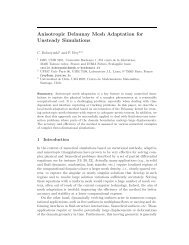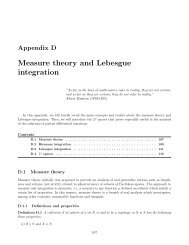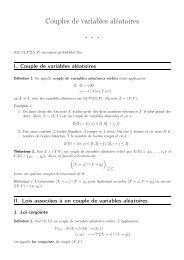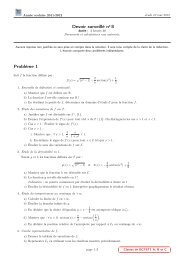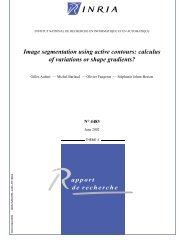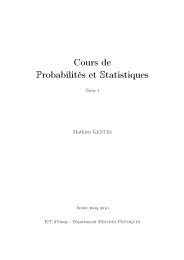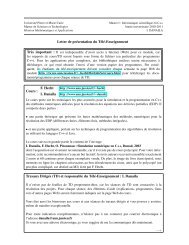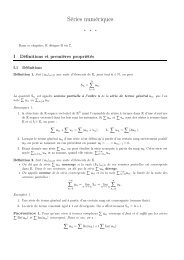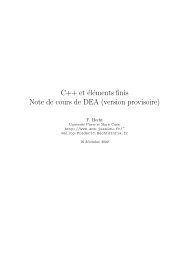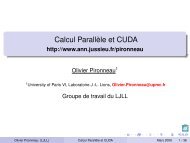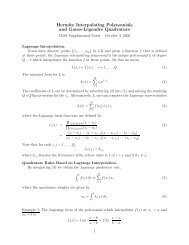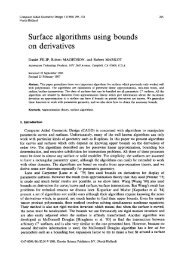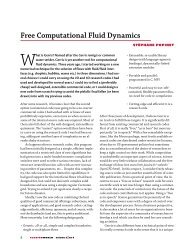pdf file
pdf file
pdf file
Create successful ePaper yourself
Turn your PDF publications into a flip-book with our unique Google optimized e-Paper software.
BOGOLIUBOV SPECTRUM OF INTERACTING BOSE GASES 15<br />
For this we need two new conditions. At positive temperature the stability<br />
of the system does not follow from the simple relative boundedness assumptions<br />
(A1) on w. So we need the following<br />
(A4) (Stability). There exists β0 > 0 such that Fβ0 �<br />
(N) ≥ −CN for all N<br />
and TrF+ e−β0H � < ∞.<br />
Our second new assumption is a modified version of the zero-temperature<br />
condensation (A3), which we now only assume to hold for the Gibbs state<br />
at temperature β −1 for simplicity.<br />
(A3’) (Bose-Einstein condensation at positive temperature). For any β−1 <<br />
, one has<br />
β −1<br />
0<br />
〈u0,γβ,Nu0〉<br />
lim = 1 (24)<br />
N→∞ N<br />
where γβ,N is the one-body density matrix of the Gibbs state Γβ,N := e−βHN /Tr � e−βHN �<br />
, namely, in terms of kernels,<br />
�<br />
γβ,N(x,y) := N Γβ,N(x,x2,...,xN;y,x2,...,xN)dx2...dxN.<br />
Ω N−1<br />
Letusremarkthatifthestrongcondensationassumption(A3s)holdstrue<br />
�<br />
for some ε0 ∈ (0,1) and TrF+ e−(1−ε0)β0H � < ∞ for some β0, then we can<br />
prove (A3’) and (A4) for the corresponding β0. We of course always assume<br />
that (A1) and (A2) hold true. Moreover, if h ≥ ηH and K1 = K2 ≥ 0, then<br />
dΓ(h+C)+C ≥ H ≥ dΓ(h−ε)−Cε<br />
�<br />
(see (69) in Appendix A), and hence the condition TrF+ e−(1−ε0)β0H � < ∞<br />
is equivalent to Tr � e −(1−ε0)β0h � < ∞. The latter holds true if we have<br />
Tr � e −(1−ε0)(1−α1)β0T � < ∞, because h ≥ (1−α1)T −C, where α1 ∈ (0,1) is<br />
given in Assumption (A1).<br />
Our main result is the following<br />
Theorem 3 (Positive temperature case). Assume that (A1)-(A2)-(A3’)-<br />
(A4) hold true. Then for every β−1 < β −1<br />
0 , we have<br />
lim<br />
n→∞ TrF+<br />
�<br />
�<br />
�UNe −β(HN−NeH) ∗<br />
UN −e −βH<br />
�<br />
�<br />
� = 0.<br />
This implies the convergence of the corresponding Gibbs states and of the<br />
free energy:<br />
lim<br />
N→∞ (Fβ(N)−NeH) = −β −1 �<br />
logTrF+ e −βH�<br />
.<br />
Theorem 3 is proved using the same argument as that of the proof of Theorem<br />
2, together with a well-known localization inequality for the entropy,<br />
see Section 7.2.



